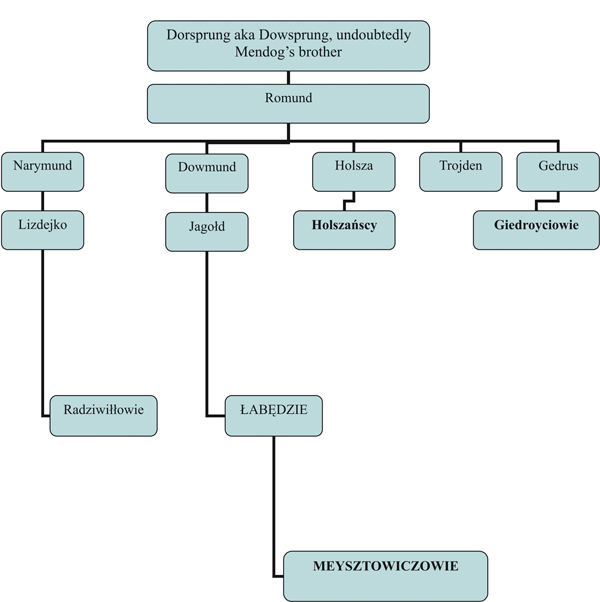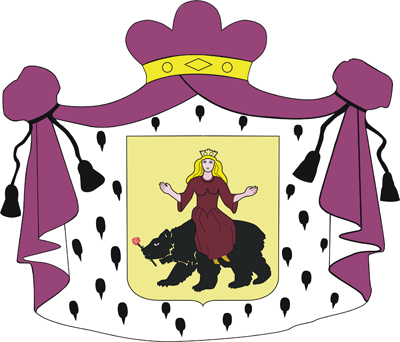Meysztowicz - genealogy
Recently, almost ninety years after their loss, some items once belonging to Aleksander Meysztowicz have returned to the family. The many different objects include a signet ring and two stamps originating from either the end of the 19th century or the very beginning of the 20th century that feature the princely coronet above the family coat of arms of Rawicz. The most interesting from the heraldic point of view is the signet ring which, aside from Rawicz, features two smaller shields bearing the Kopacz and Łabędź coats of arms.
The fact that such items came to exist and function in the family must arouse a justified feeling of astonishment and wonder as to the lack of any information whatsoever about the Meysztowicz family using the princely title, their absence from official lists of titled families, and especially the lack of such a tradition in the family itself. As always in such cases, there is a suspicion of usurpation, which weakens with regard to the person who would have usurped. It is impossible to imagine that Aleksander Meysztowicz, a man who for many years held an exposed public post and was greatly respected among the landed gentry of Lithuania, would subject himself to loss of face without being deeply convinced of his origins from particular people from the beginnings of Lithuania's statehood, as well as his knowledge of detailed legal regulations in this regard. Such regulations gathered by J. Ostroróg-Sadowski in his paper titled Hereditary titles in light of the binding legal provisions, Warsaw 1899, on page 26, states that "[.] those persons whose ancestors once used a title and later neglected it, may ask to be granted a crown and coat in their family crest. A coronet featuring an ermine coat is then a symbol of princely tradition [.]"
Therefore, when aiming to solve this mystery, one must above all try to recreate the family's genealogy and, in particular, indicate its progenitor. Unfortunately the monograph of the Meysztowicz family prepared by S. Ptaszycki and J. Jakubowski, published in 1929, which constitutes a natural starting point for further research, does not provide reliable information on the family's origins. The authors have indicated as the family's progenitors the sons of a mythical (not appearing in any independent source) Meyszt - three bothers: Getowt, governor of Birszty, called a "kunigas" [prince] by a Teutonic source, who took on the coat of arms of Kopacz in Horodlo, and his brothers Jatowt and Sargowt. The authors based their theory on a late document originating from the 1600s, concerning a dispute between the Meysztowicz and Ogiński families over rights to the town of Meysztowicze.
Of these three brothers, only Getowt is noted by other independent sources. However, doubts as to the identity of this kunigas Getowt were already brought up by Oskar Halecki in a review of the aforementioned monograph, when he wrote: "It should be stressed above all that the identification of Getowt, the eldest son of the progenitor Meyszt, with the well-known boyar Getowt, who appears on the act of the Horodlo Union of 1411, is only a presumption." However, Halecki's main objection was the discrepancy between the emblem on Getowt's coat of arms - Kopacz, and that of his hypothetical descendents, the Meysztowicz family - Rawicz.
However, the authors of the monograph did not make full use of the oldest document they included (no. 1), dated 18 June 1482, which concerned the agreement on estate ownership matters between Michna Dorkiewicz and Sudek Minigajłowicz, as well as Chrzczon and Juszek Jatowtowicz regarding the property (Getowt's) of their deceased "sister" (doubtlessly their first paternal cousin), Mrs Moniek Getowt. This document also presents extremely important information that Minigajło, Sudek's father, was the brother of Jatowt and Getowt (there is no mention of Sargowt in this document). Searching for this Minigajło, we come to the privilege of Casimir Jagiellon dated 9 November 1449, in which the monarch granted the scarcely known Minigajło eight peasant workers in the estate in Stokliszki (LM 3/3, no. 3). In face of the fact that the town of Meysztowicze lay precisely in the Stokliszki estate, there is no doubt whatsoever that this Minigajło was the father of the aforementioned Sudek.
Thus, taking into account the strength of tradition and the repetition of names in certain families, especially of illustrious ancestors, alongside the simultaneous likeness of the Rawicz coat of arms, we come to Minigajło Gedygołdowicz (deceased after 1413), castellan of Vilnius, one of the most distinguished Lithuanian boyars and co-author of the Krew Union of 1386. From 1387 to 1398 Minigajło was the governor of Oszmiana and, as the castellan of Vilnius (the second highest secular post in the Great Lithuanian Kingdom), he signed the act of the Horodlo Union. Meanwhile, dropping his hitherto coat of arms of Łabędź, he took on the new coat of arms of Rawicz offered to him by the highest dignitary of the Crown, the castellan of Kraków, Krystyn of Ostrowo and Grot of Jankowice, who shared similar family origins, status and the same coat of arms. For chronological reasons we should look, in this very Minigajło, for the grandfather of the Minigajło bestowed with the Stokliszki estate in 1449 and, naturally, his brothers Getowt and Jatowt.
The charter of Witold for the boyars of the Kołtyniany district, including Minigajło, his brother Wizbor and their nephew Keistowt (Getowt), originated in the year 1415. Are we actually dealing with the same family here or are these names coincidental? It is difficult to judge.
Minigajło the castellan of Vilnius was heir, among other properties, to Dziwieniszek in the district of Oszmiana, an area with which other powerful Lithuanian families are associated, also using the Łabędź coat of arms (not linked with the "Polish" Łabędź), such as, for example, the Kieżgajło family, the Chołowczyński and Girski princes, etc. In the direct vicinity of Dziwieniszek lie Surwiliszki, which undoubtedly take their name from Surwiło, the confirmed brother of Minigajło, which in turn indicates a longer presence of the family in the district, reaching at least the times of Gedygołd, Minigajło and Surwiło's father. Goods belonging to the Gedygołdowicz family of the coat of arms of Łabędź and Moniwid Kojlinikowicz (accepted into the Leliwo coat of arms), whose brother had the characteristic name of Gedygołd, were also found in the Oszmiana district.
Minigajło was long considered to be the son of Prince Olgierd, even by such experienced researchers as Józef Wolff. This opinion was verified in newer literature and subsequently accepted also by Wolff, who in his remarkable later study titled Kniaziowie litewsko-ruscy ["Lithuanian-Ruthinian Princes"], accepted the possibility of a series of families marking themselves with the Łabędź coat of arms, originating from "independent princes of Lithuania, a dynasty that preceded the Gedyminowiczs". Simultaneously Wolff rejected the argument of "Lithuanian chronicle authors" that Dorsprung's (13th c.) five grandsons (sons of his son Romund), Narymund, Dowmund, Holsza, Trojden and Gedrus, were the progenitors of a great number of families that were considered, or considered themselves to be, princes, such as the Świrski, Giedroyć, Girski, Holszański, Radziwiłł and many other families. Elsewhere, analysing the origins of the Holszański family, Wolff wrote that they "undoubtedly belong to a small number of princes of pure Lithuanian origin, the descendents of earlier independent princes (kunigasy) from these parts." Meanwhile, from Lithuanian history, many sovereign principalities are known of within the area of the later Great Lithuanian Kingdom that, during the course of bloody battles, were subordinated during the 13th century to the authority of Mendog. Among the kunigasy [princes] ruling the different areas, sources note Dowmund, Mendog's brother-in-law, who was the ruler of the Nalszcza region (an area located to the east and southeast of Vilnius). Maybe then he was the progenitor of the families using the Łabędź coat of arms, later densely populating the Oszmiana region, such as the Szemioth, Jundziłło, Talwosz, Minigajło and Gedygołdowicz families, of which the Kieżgajłos are distinguished by their position and wealth, possessing even in the early 16th century (1528), goods greater than those of the Radziwiłł family. Therefore it cannot be ruled out, although the matter for obvious reasons requires further research, that the castellan of Vilnius, Minigajło, could also have belonged to the same family circle, cultivating traditions of princely origins, though not originating from Olgierd but the former Lithuanian dynasty or those sovereign princes-kunigasy, advocated by Mendog in the 13th century.
It is also worth mentioning that other families also lived in Lithuania, consistently stressing their princely origins, which would be impossible to find on official lists of those authorised to use the princely title. These included the Dowgiałło, Jełowicki, Piłsudski and Wańkowicz families among others, whose origins may truly reach back to the sovereign kunigasy of the 13th century.
Returning to the starting point of our reflections, which is the signet ring bearing the three coats of arms, it should be affirmed that it this an excellent source - material evidence of the genealogical awareness of the Meysztowicz family at the turn of the 19th century. The family must, at the time, have known of the existence of Getowt, who they wrongly believed to be their direct progenitor, as well as of Minigajło, who they surely weren't able to link genealogically. The content of the document dating back to 1600, which failed to mention Minigajło's name, was undoubtedly an obstacle here. The princely coronet over Rawicz is a symbol of the origination from ancient sovereign Lithuanian princes-kunigasy.
The hypothetical family tree of the descendents of Dowsprung according to the "Lithuanian chronicle"

